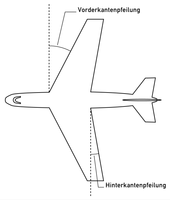Adolf Busemann (engineering scientist)
Adolf Busemann (born April 20, 1901 in Lübeck , † November 3, 1986 in Boulder , Colorado ) was a German aerodynamicist.
Life
Adolf Busemann was born in Lübeck in 1901 as the son of the engineer Cornelius Albert Busemann. After studying mechanical engineering at the Technical University of Braunschweig , he received his doctorate in 1924 under Professor Otto Föppl with a dissertation on torsional vibrations of rods, i.e. still entirely in mechanics, although Föppl also gave a lecture on aerodynamics .
After moving to the Kaiser Wilhelm Institute for Flow Research in Göttingen the following year , he came to his field of work, high-speed aerodynamics. He earned his first services through his decisive collaboration in the construction of the supersonic wind tunnel designed by Professor Ludwig Prandtl . In 1930 he completed his habilitation at the local university. A year later he received a lectureship for fluid mechanics at the TH Dresden and worked for some time at the German Research Institute for Aviation in Berlin-Adlershof . During his work he discovered the amazingly simple remedy for the problems that arose on the wing when it approached the speed of sound. It was the stronger sweep . They make the wing profile appear thinner and more elongated than it is for the flow. He first reported on this discovery, which a few years later would prove to be indispensable for high-speed flight, at the 5th Volta Congress in Rome . But at that time the international professional world took no notice of this realization. A year later, Busemann became head of the Institute for Gas Dynamics in the newly created German Research Institute for Aviation (DFL) in Braunschweig- Völkenrode , where he built a new one using parts of the wind tunnel he and Prandtl had created in Göttingen. In him and also in another, the correctness of his earlier knowledge could now be confirmed by countless series of measurements . In 1939 he and Albert Betz received a secret patent on his invention. From 1943 on there was no German aircraft manufacturer whose design offices did not already have designs that applied Busemann's findings.
For the Allied specialists who came to Germany after the end of the war, it was a great surprise when they found the results of these series of measurements. It was not until 1944 that an American scientist, Robert Thomas Jones , at the National Advisory Committee for Aeronautics (NACA) in the USA came to the same conclusion as Adolf Busemann did almost 10 years before him in Germany. After the end of the war in 1946, he first went to England to the Royal Aircraft Establishment and a year later to the USA to the Langley Research Center . In 1963 he received a professorship at the University of Colorado at Boulder , where he lived until his death. Among other things, he was honored with the award of an honorary doctorate from RWTH Aachen University , with the Ludwig Prandtl Ring and in 1970 with the appointment as a Fellow of the American Astronautical Society , as well as by being accepted as a member of the National Academy of Engineering in the USA. Today its strongly swept wing is an indispensable construction element in every modern airplane.
In November 1933 he signed the German professors' confession of Adolf Hitler . From 1950 Busemann was an "External Scientific Member" of the then Max Planck Institute for Flow Research in Göttingen. From 1943 to 1954 he was a full and then corresponding member of the Braunschweig Scientific Society .
Fonts (selection)
- The heat and material exchange. Shown in the Mollier state diagram for two-substance mixtures. Berlin: J. Springer, 1933.
- Tasks of high-speed technology. Lecture given at the 2nd scientific session of the full members of the German Academy of Aviation Research on November 12, 1937, session 1937/38. In: Writings of the German Academy of Aviation Research, issue 30. Munich, Berlin: Oldenbourg Verlag, 1940.
- Dynamics, Volume 4 of the "Lectures on Technical Mechanics" by Adolf Busemann, Ludwig Föppl and Otto Föppl. Munich: Oldenbourg Verlag, various editions, e.g. B. 9.1942.
- The axially symmetrical conical supersonic flow Luftfahrtforschung Vol. 19, 1942, p. 137
Literature about Busemann
- Ernst Heinrich Hirschel, Horst Prem, Gero Madelung: Aviation research in Germany (= Volume 30 of the series Die Deutsche Luftfahrt). Bernard & Graefe Verlag, 2001. ISBN 3-7637-6123-3
- Dietrich Hummel: The Institute for Fluid Mechanics at the TU Braunschweig. A contribution to Braunschweig's aviation history 1900–1978. Braunschweig: Appelhans Verlag, 2005. ISBN 3-937664-30-0
- Walter Tillmann: Adolf Busemann April 20, 1901 - February 3, 1986 (obituary for Busemann), in: 1986 annual report and 1985 financial statements of the Max Planck Society: Obituaries, series: Max Planck Society, reports and communications, issue 4/87 ( 1987)
- Andreas Haka: Social networks in mechanical engineering at German university and non-university research institutions 1920–1970 , Stuttgart contributions to the history of science and technology, Vol. 6. Berlin: Logos Verlag, 2014. ISBN 978-3-8325-3695-4
Web links
- Literature by and about Adolf Busemann in the catalog of the German National Library
Individual evidence
- ↑ Andreas Haka: Social networks in mechanical engineering at German university and non-university research institutions 1920–1970. Logos, Berlin 2014 ISBN 978-3-8325-3695-4 p. 113
- ↑ Werner Heinzerling: Wing arrowhead and area rule - two basic German patents of aircraft aerodynamics . P. 4–6 ( PDF )
| personal data | |
|---|---|
| SURNAME | Busemann, Adolf |
| BRIEF DESCRIPTION | German-American aerodynamicist |
| DATE OF BIRTH | April 20, 1901 |
| PLACE OF BIRTH | Lübeck |
| DATE OF DEATH | 3rd November 1986 |
| Place of death | Boulder , Colorado , USA |

